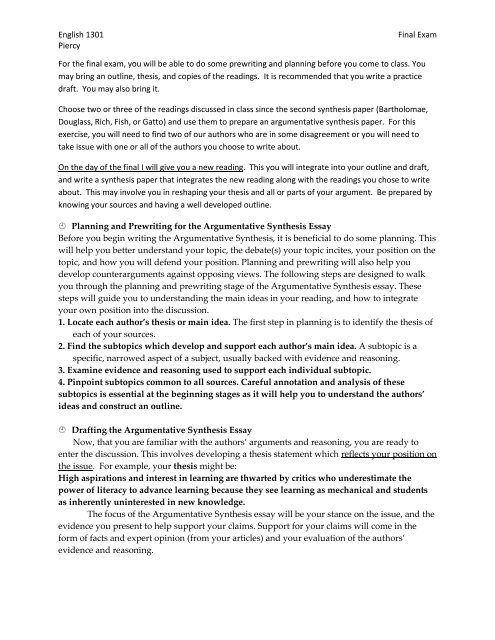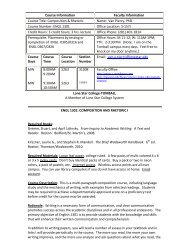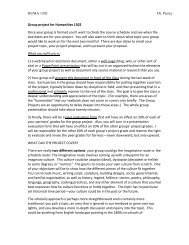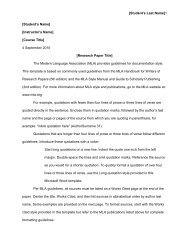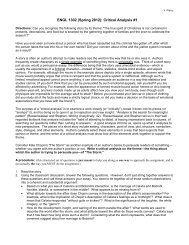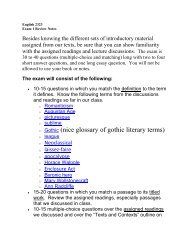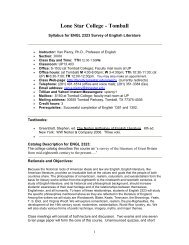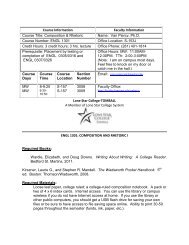English 1301 Final Exam Piercy For the final exam, you will be able ...
English 1301 Final Exam Piercy For the final exam, you will be able ...
English 1301 Final Exam Piercy For the final exam, you will be able ...
Create successful ePaper yourself
Turn your PDF publications into a flip-book with our unique Google optimized e-Paper software.
<strong>English</strong> <strong>1301</strong><br />
<strong>Piercy</strong><br />
<strong>Final</strong> <strong>Exam</strong><br />
<strong>For</strong> <strong>the</strong> <strong>final</strong> <strong>exam</strong>, <strong>you</strong> <strong>will</strong> <strong>be</strong> <strong>able</strong> to do some prewriting and planning <strong>be</strong>fore <strong>you</strong> come to class. You<br />
may bring an outline, <strong>the</strong>sis, and copies of <strong>the</strong> readings. It is recommended that <strong>you</strong> write a practice<br />
draft. You may also bring it.<br />
Choose two or three of <strong>the</strong> readings discussed in class since <strong>the</strong> second syn<strong>the</strong>sis paper (Bartholomae,<br />
Douglass, Rich, Fish, or Gatto) and use <strong>the</strong>m to prepare an argumentative syn<strong>the</strong>sis paper. <strong>For</strong> this<br />
exercise, <strong>you</strong> <strong>will</strong> need to find two of our authors who are in some disagreement or <strong>you</strong> <strong>will</strong> need to<br />
take issue with one or all of <strong>the</strong> authors <strong>you</strong> choose to write about.<br />
On <strong>the</strong> day of <strong>the</strong> <strong>final</strong> I <strong>will</strong> give <strong>you</strong> a new reading. This <strong>you</strong> <strong>will</strong> integrate into <strong>you</strong>r outline and draft,<br />
and write a syn<strong>the</strong>sis paper that integrates <strong>the</strong> new reading along with <strong>the</strong> readings <strong>you</strong> chose to write<br />
about. This may involve <strong>you</strong> in reshaping <strong>you</strong>r <strong>the</strong>sis and all or parts of <strong>you</strong>r argument. Be prepared by<br />
knowing <strong>you</strong>r sources and having a well developed outline.<br />
Planning and Prewriting for <strong>the</strong> Argumentative Syn<strong>the</strong>sis Essay<br />
Before <strong>you</strong> <strong>be</strong>gin writing <strong>the</strong> Argumentative Syn<strong>the</strong>sis, it is <strong>be</strong>neficial to do some planning. This<br />
<strong>will</strong> help <strong>you</strong> <strong>be</strong>tter understand <strong>you</strong>r topic, <strong>the</strong> debate(s) <strong>you</strong>r topic incites, <strong>you</strong>r position on <strong>the</strong><br />
topic, and how <strong>you</strong> <strong>will</strong> defend <strong>you</strong>r position. Planning and prewriting <strong>will</strong> also help <strong>you</strong><br />
develop counterarguments against opposing views. The following steps are designed to walk<br />
<strong>you</strong> through <strong>the</strong> planning and prewriting stage of <strong>the</strong> Argumentative Syn<strong>the</strong>sis essay. These<br />
steps <strong>will</strong> guide <strong>you</strong> to understanding <strong>the</strong> main ideas in <strong>you</strong>r reading, and how to integrate<br />
<strong>you</strong>r own position into <strong>the</strong> discussion.<br />
1. Locate each author’s <strong>the</strong>sis or main idea. The first step in planning is to identify <strong>the</strong> <strong>the</strong>sis of<br />
each of <strong>you</strong>r sources.<br />
2. Find <strong>the</strong> subtopics which develop and support each author’s main idea. A subtopic is a<br />
specific, narrowed aspect of a subject, usually backed with evidence and reasoning.<br />
3. <strong>Exam</strong>ine evidence and reasoning used to support each individual subtopic.<br />
4. Pinpoint subtopics common to all sources. Careful annotation and analysis of <strong>the</strong>se<br />
subtopics is essential at <strong>the</strong> <strong>be</strong>ginning stages as it <strong>will</strong> help <strong>you</strong> to understand <strong>the</strong> authors’<br />
ideas and construct an outline.<br />
Drafting <strong>the</strong> Argumentative Syn<strong>the</strong>sis Essay<br />
Now, that <strong>you</strong> are familiar with <strong>the</strong> authors’ arguments and reasoning, <strong>you</strong> are ready to<br />
enter <strong>the</strong> discussion. This involves developing a <strong>the</strong>sis statement which reflects <strong>you</strong>r position on<br />
<strong>the</strong> issue. <strong>For</strong> <strong>exam</strong>ple, <strong>you</strong>r <strong>the</strong>sis might <strong>be</strong>:<br />
High aspirations and interest in learning are thwarted by critics who underestimate <strong>the</strong><br />
power of literacy to advance learning <strong>be</strong>cause <strong>the</strong>y see learning as mechanical and students<br />
as inherently uninterested in new knowledge.<br />
The focus of <strong>the</strong> Argumentative Syn<strong>the</strong>sis essay <strong>will</strong> <strong>be</strong> <strong>you</strong>r stance on <strong>the</strong> issue, and <strong>the</strong><br />
evidence <strong>you</strong> present to help support <strong>you</strong>r claims. Support for <strong>you</strong>r claims <strong>will</strong> come in <strong>the</strong><br />
form of facts and expert opinion (from <strong>you</strong>r articles) and <strong>you</strong>r evaluation of <strong>the</strong> authors’<br />
evidence and reasoning.
<strong>English</strong> <strong>1301</strong><br />
<strong>Piercy</strong><br />
<strong>Final</strong> <strong>Exam</strong><br />
(IMPORTANT: On <strong>the</strong> day of <strong>the</strong> <strong>final</strong>, read <strong>the</strong> new article <strong>you</strong> are given and go back<br />
through <strong>the</strong> prewriting steps 1-4 with it. Then select points and quotes from <strong>the</strong> article that <strong>will</strong><br />
fit into <strong>you</strong>r argument.)<br />
Typically, <strong>you</strong>r <strong>the</strong>sis <strong>will</strong> come at <strong>the</strong> <strong>be</strong>ginning of <strong>you</strong>r essay. Once <strong>you</strong> familiarize<br />
<strong>you</strong>r audience with <strong>the</strong> topic, 1) provide background, and 2) establish <strong>the</strong> need for <strong>the</strong><br />
argument, 3) assert <strong>you</strong>r position (<strong>you</strong>r <strong>the</strong>sis statement).<br />
One of <strong>the</strong> main criterions of a sound argument is <strong>the</strong> ability to present and incorporate<br />
multiple viewpoints and evaluate <strong>the</strong> evidence and reasoning of those viewpoints. You have<br />
already done most of this section in <strong>the</strong> planning and prewriting stage of <strong>the</strong> Argumentative<br />
Syn<strong>the</strong>sis essay (see #’s 1‐ 3 from this handout’s Planning and Prewriting) section.<br />
The next part of <strong>you</strong>r paper is where <strong>you</strong> present and refute opposing arguments, as<br />
well as integrate support for <strong>you</strong>r argument. When <strong>you</strong> develop <strong>you</strong>r own argument, offer<br />
convincing and credible evidence in support of <strong>you</strong>r proposition (<strong>the</strong>sis statement). Use <strong>the</strong><br />
outline <strong>you</strong> created in <strong>the</strong> Planning and Prewriting section of <strong>the</strong> handout. Notice how we<br />
integrate our evaluation of each author’s evidence and reasoning with our argument. With <strong>the</strong><br />
integrated approach, this section is organized according to subtopics.<br />
<strong>Final</strong>ly, <strong>you</strong> <strong>will</strong> bring <strong>the</strong> paper to an end with <strong>you</strong>r conclusion. This is <strong>you</strong>r <strong>final</strong><br />
opportunity to convince <strong>you</strong>r audience that <strong>you</strong>r position is valid. What <strong>will</strong> buying <strong>you</strong>r<br />
argument achieve? Summarize <strong>you</strong>r strongest arguments and restate <strong>you</strong>r position.


